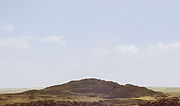
Pyramid of Merenre
Encyclopedia


Pharaoh
Pharaoh is a title used in many modern discussions of the ancient Egyptian rulers of all periods. The title originates in the term "pr-aa" which means "great house" and describes the royal palace...
Merenre was constructed during the Egypt
Egypt
Egypt , officially the Arab Republic of Egypt, Arabic: , is a country mainly in North Africa, with the Sinai Peninsula forming a land bridge in Southwest Asia. Egypt is thus a transcontinental country, and a major power in Africa, the Mediterranean Basin, the Middle East and the Muslim world...
ian sixth dynasty
Sixth dynasty of Egypt
The sixth dynasty of ancient Egypt is often combined with Dynasties III, IV and V under the group title the Old Kingdom.-Pharaohs:...
at Saqqara
Saqqara
Saqqara is a vast, ancient burial ground in Egypt, serving as the necropolis for the Ancient Egyptian capital, Memphis. Saqqara features numerous pyramids, including the world famous Step pyramid of Djoser, sometimes referred to as the Step Tomb due to its rectangular base, as well as a number of...
450 metres to the south-west of the pyramid of Pepi I and a similar distance to the pyramid of Djedkare. Its ancient name was "Merenre's beauty shines" or perhaps "The Perfection of Merenre Appears". Today it consists mostly of ruins; it is hard to get to and is not open to the public.
The pyramid was built 52.5 metres in height, 78.75 metres in base length with an inclination of 53°07'48". The causeway is 250 metres long and the complex was surrounded by a wall of mud brick.
Only traces of the mortuary temple have been found and the evidence indicates that construction was halted abruptly at one point and never resumed, probably upon the Pharaoh's death.
The entrance to the burial chambers is on the north face which descends to a vestibule where another shaft leads to the antechamber. To the right of the antechamber is the burial chamber; to the left is another small room, a Serdab
Serdab
A serdab , literally meaning "cold water", which became a loan word in Persian for 'cellar') is an ancient Egyptian tomb structure that served as a chamber for the Ka statue of a deceased individual. Used during the Old Kingdom, the serdab was a sealed chamber with a small slit or hole to allow the...
. In the burial chamber a sarcophagus decorated with polychrome reliefs stood against the wall; when found, it was in good condition although it had been plundered. The ceiling of the burial chamber had an astrological theme and was covered with stars.
Excavations
The pyramid was first examined in the 1830s by John Perring. Later in the 1880s the subterranean chambers were explored by Gaston MasperoGaston Maspero
Gaston Camille Charles Maspero was a French Egyptologist.-Life:Gaston Maspero was born in Paris to parents of Lombard origin. While at school he showed a special taste for history, and by the age of fourteen he was already interested in hieroglyphic writing...
who was in search of pyramid texts (inscriptions on the walls describing the Pharaoh's reign); his expedition discovered a mummy inside the pyramid which was thought to be from some later burial although some modern scholars now believe that it was the mummy of Merenre after all. If so, that would make it the oldest-known mummy. Since the late 20th century a French team led by Jean Leclant
Jean Leclant
Jean Leclant was a renowned Egyptologist who was an Honorary Professor at the College of France, Permanent Secretary of the Academy of Inscriptions and Letters of the Institut de France, and Honorary Secretary of the ....
has been researching the site.

